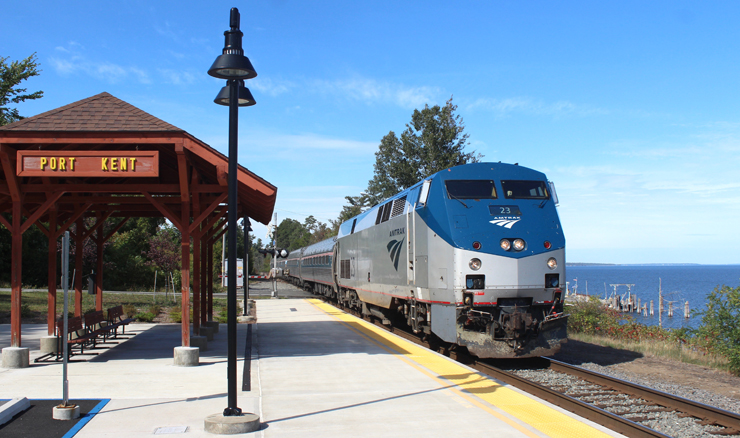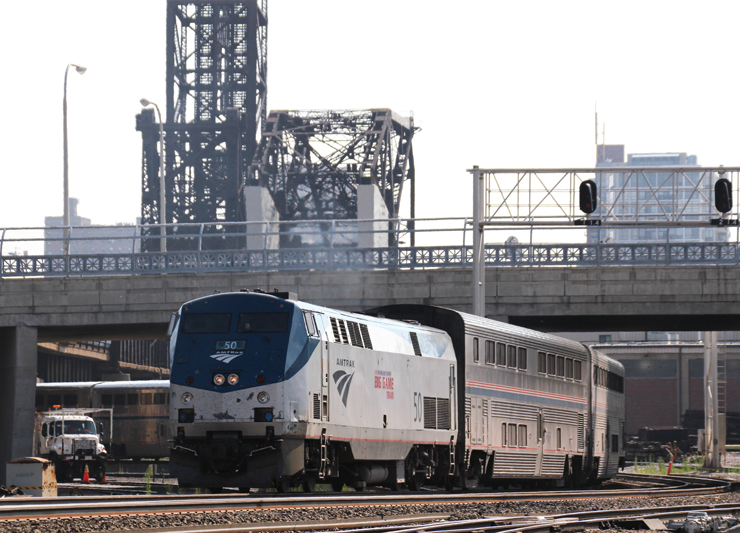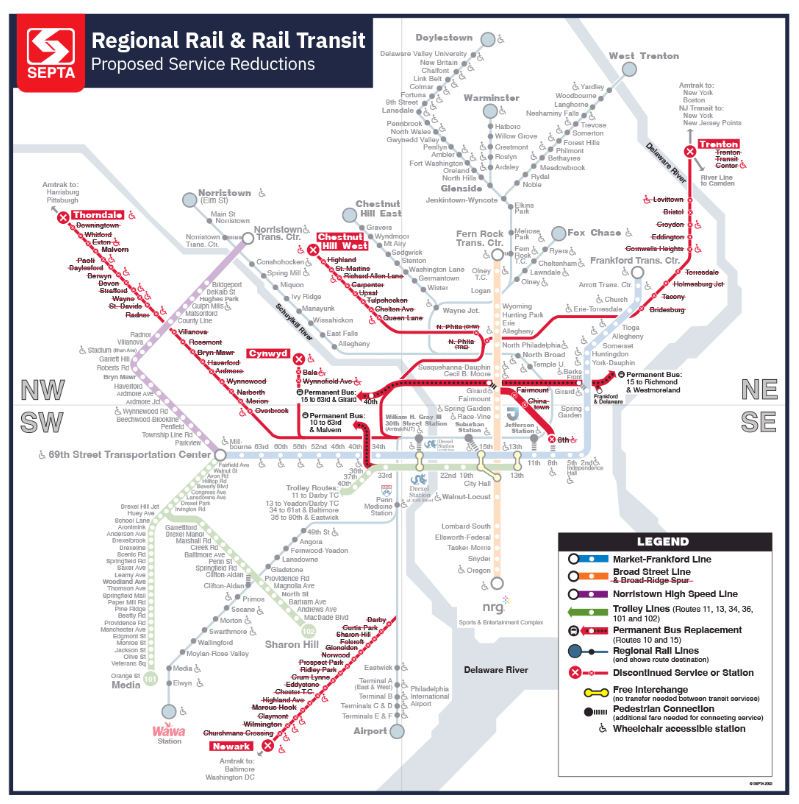WASHINGTON — Railroads hosting Amtrak trains have challenged the Federal Railroad Administration’s attempt to simplify and quantify on-time performance measurement.
The railroads’ main beef with the “Notice of Proposed Rulemaking” published on March 31 [see “FRA floats new on-time rules,” “Passenger,” June 2020 Trains]: the rules didn’t go far enough because the FRA suggested — but won’t require — passenger train schedules to be renegotiated.
The Association of American Railroads, Canadian National, Canadian Pacific, CSX Transportation, and Norfolk Southern supplied written statements and testified in a telephone-only public hearing on April 30 as part of the required comment period that ends June 1. Other organizations weighing in included the Rail Passengers Association, Association of Independent Passenger Rail Operators, and the Midwest Rail Commission.
Background: Pros and cons, as railroads see them
Most carriers applaud adoption of a single measure rather than multiple definitions of when a train is late, depending on the length of the route traveled. That complicated attribute of the previous metric was voided by host railroads’ court challenges. The FRA’s proposed “Customer OTP” rule establishes a 15-minute threshold at all stations along a route, weighted by the number of passengers using each station.
Concerns include:
— The FRA’s “Train Schedule Principles” imply that existing schedules are mostly accurate; the agency expects Amtrak and hosts to redistribute recovery time, or padding, throughout a train’s route to allow it to “recover” its published schedule. Michael Metteucci, CN’s regional director of contracts and administration, points out that station times on most of its routes have not been adjusted for years, so they may not be “reasonably achievable.”
— Formulating new schedules will be contentious. Norfolk Southern’s Senior Director of Interline Services, Randall Hunt, contends Amtrak schedule-making must account for “operating and market conditions affecting the railroad, including infrastructure capacity, traffic volumes, traffic mix, and maintenance needs,” then insists, “Amtrak is unwilling to adjust schedules in response to these factors.”
— The FRA did not establish a dispute-resolution process if Amtrak and host railroads can’t agree. Chuck Hubbard, CP’s director of interline and passenger operations, articulates this weakness even though his company consistently gets the highest marks in Amtrak’s quarterly on-time performance “report card” for host carriers. Hubbard also believes the agency should mandate periodic schedule adjustments, not just suggest them.
— One host railroad will be blamed if another host delivers a train “out of slot.” Hubbard uses the example of the New York-Montreal Adirondack, which must arrive at passing sidings 30 miles apart on a single-track railroad to keep it schedule when meeting other trains, including its opposite direction counterpart. If CN or Amtrak inflict delays that cause a 40-minute wait, why should CP be penalized? Andy Daly, CSX’s Senior Director of Passenger Operations testifies, “A key shortcoming of the proposed rule is its failure to adopt individual performance on multi-carrier routes in the definition of OTP.”
— Amtrak is not compelled to publicly share the ridership data that shows which stations handle the most passengers, and there is no guidance on how often those numbers will be reviewed to trigger a schedule change. Daly notes railroads have not been shown examples of Amtrak’s data to see how the application might work.
If these issues aren’t addressed, all railroad respondents warn, adequately-performing carriers would be wrongly penalized and the STB burdened with a flood of investigations. Canadian Pacific’s Hubbard is also concerned that such proceedings would cause “unnecessary friction” between his company and Amtrak.
Analysis: good-faith effort needed to avoid slower schedules
The carriers are right. Most schedules were established years ago, if not decades. But they haven’t been revised because renegotiating schedules has become a tortured process. It affects financial incentives Amtrak pays to its hosts if trains are on time at certain mid-route checkpoints and endpoints — and penalties if punctuality isn’t achieved.
Historically, the agreements have given railroad dispatchers enough wiggle room to garner a bonus — even with moderate delays — by putting virtually all recovery time just prior to the final stop or checkpoint. For instance, CN is given twice as much time, 45 more minutes, to get the northbound City of New Orleans from Homewood, Ill., to Chicago than its southbound counterpart receives for those 25 miles.
Now all of these contracts, not just schedules, must be renegotiated to reflect how much passenger activity takes place at every station along the route.
As for what is “reasonably achievable,” if Amtrak had been willing to adjust its schedules during the fall of 2016 congestion meltdown on the Chicago-Toledo, Ohio, portion of NS’ east-west main line, or during the last two years on the all-NS New Orleans-Washington, D.C. Crescent route, the price of being “on time” would be appreciably slower schedules that could chase riders away.
The primary reason Amtrak has chosen to stick with what it has is because the railroads insist on lengthening schedules. Furthermore, establishing a “market conditions” or “traffic volumes” metric is a slippery slope compared to “pure running time,” defined by the FRA as “the minimum amount of time required for a train to operate between two locations via its normal routing.” This, plus recovery time and station dwell time, are the building blocks of passenger train schedules.
Rail Passengers Association President and CEO Jim Mathews bemoaned “endless litigation delays” by the Class Is in their attempt to counteract past efforts to hold host railroads accountable for on-time performance and Amtrak’s statuory right of operating preference. Without the threat of regulation, some railroads consistently make Amtrak trains wait, while other dispatchers, such as those at CP, BNSF Railway (which did not testify), and most recently CSX, continue to keep passenger train routes fluid.
Another common thread in the testimony is Amtrak’s lack of transparency in sharing data. This was reflected in the Rail Passengers Association presentation, by Ray Chambers, President of the Association of Independent Railway Operators, and in post-hearing commenter Justin Larsen, who called into question the opacity and usefulness of Amtrak’s Customer Satisfaction Index. Contending data it collects is proprietary, as the company has claimed for the last five years in shielding operating details from the press and the public, does nothing to promote transparency.
Running trains on time shouldn’t be that difficult as long as all the parties negotiate in good faith. With the right regulatory framework, maybe some progress can finally be made.
To get a complete picture of this complicated issue, more information is available at several websites:
— The FRA’s “Notice of proposed rulemaking” is available here.
— Copies of written transcripts from host railroads and other participants at the April 30 hearing are available here.
— Additional comments submitted so far are available here.
— And those wishing to comment can do so here until June 1.
















Sorry, I accidentally posted an earlier comment I was trying to correct, my point is Amtrak is the only passenger railroad that the US has, is owned by the government and has to share tracks with the host railroads and have been doing so since 1971, with the exception of the NEC Amtrak needs to be more open about it’s reporting practicing,unlike European and Asian countries where passenger trains have their own dedicated tracks, we in the US have to make do with what we have, sometimes Amtrak appears to bully and threaten host railroads whining to Congress about this and that, half of the US doesn’t have any kind of rail service but still pay taxes supporting a service many are unable to use. Either build separate tracks (which isn’t feasible) or find a way of better disclosing, being realistic about doing business with the railroads, it seems both need each other.
Amtrak is like a person who is invited into someones home, then complain about not having diner served like they want it, unlike eurpoen and asian
1985. Transcontinental train trip. With one exception, trains were on time, and veteran operating crews apologized if we were 1-2 minutes late. It was obvious that with experience and commitment that trains could and can run right on time. It took a few years for the Amtrak operating crews to gain the experience the host railroad crews had (many with 25-30 years experience on their respective railroads)
Should he knows it is run?
NOW is not running.and the I call run?
Have to agree Gerald, the railways seem to be so much more efficient in the UK as well as most of Western Europe. The only problem I see in NA is distance. Short fast freight, Rio Grande, FEC style. Problem is the desire to run two mile trains to save $, corporate and Wall Street greed vs a very fluid customer oriented transportation system.
Yes, GRALD – Seize the railroads, nationalize them. Except that you need to pay for them. Then after seizing the railroads, you have the same problem as the dog that chases the car – once the dog grabs the car with his teeth, the dog finds it a bit difficult to swallow.
Tough and complicated my rear end, the next re-authorization legislation for Amtrak needs to reiterate that passenger trains travelling over Class 1 rails have precedence over ALL other traffic, and the railroads will have to bend over backwards to accommodate the service, or we’ll just take their private right of ways and nationalize them. Then put out freight service in corridors to competitive bidding, go the UK route and create a nationwide infrastructure owning private enterprise(with over site) that owns all the rail routes in the U.S., then you have competitive bidding for freight and passenger service by corridors or regions, depending on how traffic flows.That example of the Adirondack is a prime example of the cheapness of the railroads. Sidings 30 miles apart, fine, if they’re currently 30 miles apart and it causes dispatching problems then the solution is to build intermediate sidings so that all sidings are 15 miles apart. Problem solved and it improves your freight schedules as well, just common sense that doesn’t exist in the railroad executive suites anymore.
I think the Class 1s need to examine their own sense of import to the economy compared to that of Amtrak. Less viewing of the latter as the useless, annoying, won’t get a job, will never grow up, red headed step-child needs to happen. Please excuse my referencing of Star Trek, but everybody involved needs to do the equivalent of taking the Vulcan Kohlinar emotional discipline course to take the feelings out of the equation and enable the best compromise possible.
Prior to their final discontinuance in 1977, Rail Passenger trains were essentially saved by the money made off of the RPO’s…. In the 1960’s when the US Post Office started looking for alternatives to RPO service, did the railroads start major passenger train efforts at ‘kiling them off’…
The only RR arguement here that I can agree with is not being punished for a late handoff from another RR. The rest of their arguments are BS.
Great story on a tough and complicated issue. Thanks!
When Amtrak took over passenger service in 1971, Penn Central was incapable of running the NY-Chicago 40-41 or NY-StL 30-31* (both via ex-PRR) on the schedules AMTK had inherited. Track conditions did not permit it and neither PC nor AMTK had the money to repair the track. AMTK was not authorized to publish a slower schedule than they had inherited so they put a disclaimer in the public timetable to the effect that the trains would not run on time. . * 30-31 continued between StL and Kansas City via MoPac but this is about Penn Central’s timekeeping.
TERRY GREEN – Agree 100%.
This is some of Bob Johnston’s best work. Bravo!
The railroads pretty much view Amtrak as they do their customers – A BURDEN. They seem to be entering a phase like many other companies do when they are about to fold up, sell assets, try to squeeze as much money out as possible & then sell out or file bankruptcy. This decline in traffic from PSR even before the pandemic could result in the next and final decline of America’s RR’s. There will probably be some more mergers before then to wring out the last of any remaining monetary value, but in the end I think it will be up to the states & Fed govt maybe some public/private venture to maintain rail service otherwise I believe the RR’s current path to profit is to put themselves out of business.